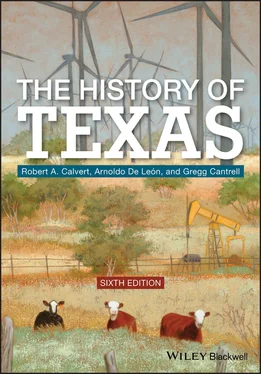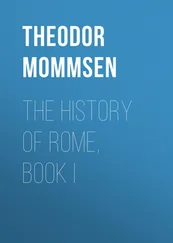1 ...8 9 10 12 13 14 ...37 Missionaries acted for the government in a tradition traceable to medieval times, when the reconquista became a joint enterprise between the Crown and the Church. As Ferdinand and Isabella acquired the right to make appointments to religious positions (the patronato real ) in the 1480s, the alliance between the king of Spain and the pope became even closer. By the time of the conquistadores, the Crown had won the right to regulate the Church in its American colonies (including making such decisions as to where Church edifices would be erected), sponsor evangelical forays into pagan lands, and decide which religious order would take priority in missionizing particular regions. With these powers, the Crown controlled the pattern of Church activities in the New World, though doctrine and dogma remained strictly the domain of the clergy.

Figure 1.6 Mission San José, San Antonio.
Source: Texas Prints and Photograph Collection CN 08004, The Dolph Briscoe Center for American History, The University of Texas at Austin.
In their further efforts to Europeanize new lands, the Spaniards also used the civilian settlement, another institution employed during the reconquista to hold recently reconquered territory. As the Spaniards advanced northward from Anáhuac, they used civilian settlements to populate frontier regions and integrate the hinterlands and their resources into the kingdom. By this time, the Spaniards had devised extensive laws governing the location, layout, and defense of urban outposts. Again, these laws generally derived from previous experiences in urban settlement during the reconquista. According to these plans, the town plat was square and included one or more rectangular plazas, the main one constituting the town center, with outlying streets crossing one another at right angles. The east side of the central plaza was designated for church edifices, the west side for government and public buildings. This arrangement facilitated daily routines: the idea was to use the morning light for mass and other church operations, and then allow government officials to work late into the evening using the afternoon sun. Lots allocated to residents also conformed to the pattern of perpendicular streets oriented to the four cardinal directions. Lands surrounding the new urban sites were designated as public property that all residents could use to sustain themselves and their livestock. Other ordinances stipulated that sites for new municipalities be chosen only after thought had been given to matters of sanitation, the proximity of food resources, local weather patterns, and the prospects afforded for self‐defense against raids by hostile Indians. Pobladores (settlers) made every effort to adhere to these regulations, but the contingencies of the moment many times dictated otherwise. In Texas, therefore, plans did not always follow the letter. Officials who belonged to a bureaucratic structure, the roots of which went back to the reconquista, governed these new municipalities.
The Spaniards also utilized the rancho (ranch) to help them claim unsettled areas. Stockmen and farmers invariably accompanied frontier expeditions, and, over the course of time, they played supportive roles in the Christianizing of the Indians and the defense of settled territories. Rancheros (ranchers) provided settlements with resources otherwise absent on the frontier, such as beef, pork, and wool, along with useful byproducts such as hides and tallow. This helped the missionaries retain Indian convertees who otherwise might have chosen to run off in search of wild game more palatable to their diet than the friars’ normal fare. The ranchers also helped presidial soldiers, not only by providing them with meat but by furnishing them with live animals necessary for farm work, freighting, and, of course, military expeditions of all kinds.
These, then, were the traditional institutions that the Spanish employed, albeit in a modified form, to settle the contemporary American Southwest, while the Dutch, English, and French sought footholds in the region east of the Mississippi River. Spain renewed its efforts to colonize New Spain’s Far North because of the prospects of finding wealth, a persistent desire to Christianize the settled Indians reported by Coronado, and the need to protect the expanse from foreign encroachment, for by the late 1570s and 1580s, English pirates such as Sir Francis Drake began sailing along the California coast. In 1598, therefore, Don Juan de Oñate led an expedition into what would become Nuevo México; the operation resulted in the founding of Santa Fe in 1609. The establishment of this permanent settlement initiated the Spanish government’s quest to impose its imperial authority over Texas.
Spain’s initial and strongest competition in the colonization of Texas came not from rival European empires but from indigenous nations of the region. As of the late seventeenth century (and later for that matter), Native American peoples comprised the land’s political and economic (as well as demographic) powers. In actuality, several Indian nations vied to claim the wide expanse, all of them competing for its natural (animal and plant) resources, material bounties (such as captives, guns, and livestock), or for the control of trade networks or potential intertribal coalitions. In their aim to settle Texas, therefore, the Spaniards found themselves one player among many–all intent on gaining dominion of the province’s resources.
For years, Jumano Indians had traveled to the Pueblo country in New Mexico to conduct trade. In 1629, the Jumanos asked the Spaniards they met there to visit them in their West Texas lands and instruct them in the religion to which they had been introduced by the “Lady in Blue.” According to some church historians, this personage was the Spanish nun Madre María de Ágreda, who asserted that she had spiritually visited New World lands through miraculous bilocation. Whatever the truth to the mystery surrounding this figure, the Spaniards responded to the invitation with an expedition to Jumano country in 1629 commanded by Fray (Father) Juan de Salas, and another one in 1632, led by the Franciscans.
Their desire to proselytize Native Americans notwithstanding, the Spaniards also held interests in more mundane things in Jumano country: namely, freshwater pearls (found in mollusks living in the western tributaries of the Colorado River) and the countless buffalo on the West Texas plains. Also appealing to them was the possibility that Jumano country might become a base for trading with the Caddo Indians; the eastern tribes, according to the Jumanos, comprised a wealthy population of many villages. In 1654, therefore, Diego de Guadalajara returned to Jumano country in search of pearl‐bearing conchas (shells) in the present‐day forks of the Concho River of West Texas. At that time, however, Spanish officialdom lacked the resources to pursue their plans to trade with East Texas Indians through the Jumanos.
Finally, approaches to West Texas were made in 1683 and 1684. By now, the Spaniards resided a bit closer to the Jumanos, for the Pueblo Revolt of 1680, in which the Pueblo tribes attacked and destroyed the Spanish settlements of the upper valley of the Rio Grande, had caused much of the Spanish population of New Mexico to take refuge in El Paso (modern‐day Juárez), where a Franciscan mission, which sheltered a small band of Jumanos, had existed since 1659. From this distressed and impoverished civilian settlement the Spaniards returned to West Texas when the Jumano Chief Juan Sabeata asked that priests be sent to his land in West Texas and, parenthetically, for assistance in countering threats from the Apaches. Responding to Sabeata’s request, Spanish authorities dispatched an expedition led by Juan Domínguez de Mendoza and Fray Nicolás López down the Rio Grande from El Paso to today’s Ruidosa, Texas, then into the San Sabá River area, where they established themselves at Mission San Clemente. From temporary quarters there, the expedition’s men slaughtered some 4000 buffalo. In fact, Sabeata’s primary motive in luring the Spaniards into Jumano country may have been to get the Spaniards to protect his people from the Apaches while the Jumanos hunted buffalo. The Jumanos then planned to carry Spanish goods and trade them with the Caddos of East Texas. But the Spaniards’ motivations went beyond converting Indians and shielding Sabeata from the Apaches. Aside from the previously mentioned desire to find pearls, acquire new sources of food or raw products (such as hides), and establish trading links with the Caddos, they sought to bring relief to the starving civilian community in El Paso. They also surmised that exploring West Texas might lead to an alternative site for settlement, for the El Paso region seemed unable to produce basic necessities. Whatever the motives for all involved, the Spaniards left after six weeks of hunting in San Clemente, returning to El Paso with a bounty of buffalo hides, promising the Jumanos to return at a later date.
Читать дальше











